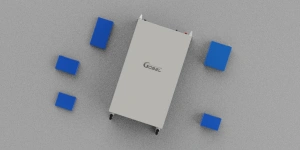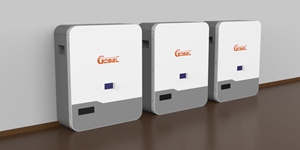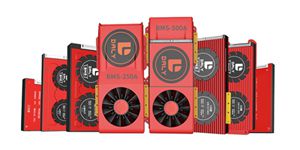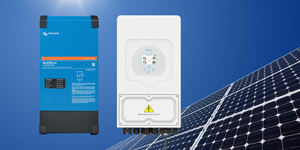HOME ENERGY STORAGE INDUSTRY RESEARCH: HIGH GROWTH CONTINUES
By Kelly posted 2022-09-17 11:18:571. Home storage products: the trend towards all-in-one machines and higher charging capacity
1.1 Products: Supporting Demands for the Stock and Incremental Household Photovoltaic Market
Home energy storage is usually used in conjunction with household photovoltaics, and the installed capacity has ushered in rapid growth. Home energy storage system, also known as battery energy storage system, its core is a rechargeable energy storage battery, usually based on lithium-ion or lead-acid batteries, controlled by a computer, and realizes charging and discharging under the coordination of other intelligent hardware and software. cycle. The home energy storage system can usually be combined with distributed photovoltaic power generation to form a home solar energy storage system. From the user side, the home solar energy storage system can reduce the electricity bill while eliminating the adverse effects of power outages on normal life; from the grid side, the home energy storage equipment that supports unified dispatching can alleviate the power shortage during peak hours and save energy. The grid provides frequency correction.
According to the different coupling methods of photovoltaic and energy storage systems, it is divided into DC coupling system and AC coupling system, which are respectively suitable for the incremental market of newly installed photovoltaic systems and the stock market of installed photovoltaic systems. The larger incremental market space is the main driving force for future market growth:
(1) Incremental market (newly installed photovoltaic + energy storage systems in target households): DC-coupled products are generally used. The DC-coupled energy storage system includes a battery system and a hybrid inverter, which combines the functions of a photovoltaic grid-connected inverter and an energy storage converter. The advantage of DC coupling is that both photovoltaic and energy storage batteries are converted through hybrid inverters, and there is no need to install additional photovoltaic grid-connected inverters. The system integration is higher, installation and after-sales service are more convenient, and it is convenient for intelligent monitoring. and control. Some households that have already installed photovoltaic systems choose to remove the original photovoltaic grid-connected inverter and install a new hybrid inverter.
(2) In the stock market (target households have installed photovoltaics and newly added energy storage systems), AC-coupled products are generally used. It is only necessary to install batteries and energy storage converters without affecting the original photovoltaic system. In principle, the design of the energy storage system is not directly related to the photovoltaic system, and can be determined according to needs. The advantage of AC coupling is high safety: in AC coupling mode, energy is collected at the AC side, which can be directly supplied to the load or sent to the power grid, or can be directly charged to the battery through the bidirectional converter, and low-voltage PV and low-voltage batteries can be selected. , eliminating the risk of DC high voltage in the energy storage system.
Depending on whether the system is connected to the grid, home energy storage systems can be divided into grid-connected systems and off-grid systems. The core difference lies in whether the system is connected to the grid. Currently, most areas use a grid-connected and off-grid integrated system. (1) Grid-connected system, photovoltaic and energy storage systems can be connected to the grid, and electricity can be purchased from the grid when the power of photovoltaics or batteries is insufficient. It is suitable for areas with stable power system and relatively low electricity price. (2) The off-grid system is suitable for areas such as deserts and islands without power grids or areas where the power grid is unstable and needs to be used by itself. Use off-grid energy storage converters, usually with a diesel generator interface, to supplement power at night when the battery power supply is insufficient. (3) On-grid and off-grid all-in-one machine, with on-grid and off-grid switching function or integrating grid-connected and off-grid modes in one machine, it can switch to off-grid mode during power outage, which is suitable for unstable power systems and frequent power outages. area.
The core hardware equipment of the home energy storage system includes batteries and converters. According to the degree of integration of the products, there are mainly two modes: all-in-one machine and split machine. The current market is dominated by split machines, but all-in-one machines are the development trend of the high-end market. : (1) Split machine, some AC coupling products and DC coupling products adopt the split machine mode, the battery system and the inverter system are provided by the pack manufacturer and the inverter manufacturer respectively, and then through the integrators, distributors, installers Channels reach end users. (2) All-in-one machine, the product is an all-in-one system including a battery and an inverter, usually an AC-coupled product. Upstream battery systems and inverters provide products as suppliers, usually in the OEM mode. The supplier's brand is not displayed in the final product, and the sales and after-sales of the products are all borne by the brand owner.
According to the voltage of the battery pack, it can be divided into high-voltage battery and low-voltage battery. The industry shows a trend of switching to high-voltage battery. The main purpose is to improve efficiency and simplify system design, but at the same time, it requires higher cell consistency and BMS management capabilities. High-voltage batteries usually have a battery pack voltage of more than 48V, and can achieve high-voltage at the battery pack level by connecting multiple cells in series. In terms of efficiency, using batteries of the same capacity, the battery current of the high-voltage energy storage system is smaller, the interference to the system is smaller, and the efficiency of the high-voltage energy storage system is higher; in terms of system design, the circuit topology of the high-voltage hybrid inverter is simpler , smaller size, lighter weight and more reliable. However, high-voltage batteries are composed of multiple cells in series and parallel. The higher the voltage, the more batteries connected in series, and the higher the requirements for the consistency of the cells. At the same time, it needs to cooperate with an efficient BMS management system, otherwise it is prone to failure.
There are three types of enterprises in the industrial chain: 1) Integrators, which only make brands and purchase all equipment. Usually outsourced batteries and inverters, integrated products are sold under their own brands, with complete sales channels and strong brand power, such as Tesla, Sonnen, etc. 2) Inverter manufacturers sell inverters separately or purchase cells with integrated batteries/all-in-one machines. Inverter manufacturers benefit from the accumulation of brands and channels in the photovoltaic inverter industry and can quickly expand. The core of the energy storage system lies in the inverter's control of the battery, that is, the communication between the inverter and the battery. Inverter manufacturers have an in-depth understanding of power electronics technology and have more advantages. 3) There are two modes of participation for battery cell manufacturers. One is to supply cells for downstream brand manufacturers without participating in product integration and without brand exposure, such as Penghui Energy, Ningde Times, Yiwei Lithium Energy, etc. The business fields are relatively diverse and the application scenarios are rich. On the one hand, it can benefit from the rapid growth of the home storage industry, and on the other hand, it can synergize with other businesses; the other mode is to produce battery systems that are sold separately or purchased inverter modules at the same time. Hardware integration and software design, such as BYD, Paineng Technology. The business models of industry chain participants show two major trends: (1) Inverter and cell manufacturers are integrated downward, and product integration can strengthen the control of sales channels and improve profitability; (2) Some manufacturers focus on For equipment supply, it can open up more customers and a wider range of application scenarios, and win by quantity.
1.2 Value: The investment cost of the whole system is nearly 80,000 yuan
Take a 4.68kw photovoltaic + Wotai 5.8kwh/6kw energy storage system as an example, the total investment is about 10,000 pounds, equivalent to a unit price of 17.61 yuan/w. Among them, the photovoltaic system accounts for 32%, the component is 3.08 yuan/w, and the photovoltaic inverter is 2.56 yuan/w. The energy storage system accounts for 35%, and the unit price is 4.97 yuan/wh. Other materials + installation costs £3,400, accounting for 33%.
1.3 Trend: High-capacity battery + hybrid inverter + all-in-one machine trend
From the perspective of battery trends, energy storage batteries are evolving towards higher capacity. With the increase of residential electricity consumption, the electricity charged in each household gradually increases, and some products realize system expansion through modularization. Due to the penetration of new energy vehicles, the increase in the power of household appliances and the impact of home office, the power consumption of each household has increased, and the demand for energy storage has increased. (1) In terms of sub-regional markets, the overall charge per household has gradually increased. Taking the German market as an example, the average charge in 2021 is 8.8kwh, while the data for the same period is 8.5kwh in 2020 and 8kwh in 2019. The increase in electricity consumption in the German market is mainly due to the development of new energy vehicles and the increase in household electricity consumption. (2) Modular battery for easy capacity expansion. The charge and power of a single product are limited, and the manufacturer will set the product to achieve flexible configuration through modular combination to meet the needs of different capacity scenarios. (3) The battery moves from low voltage to high voltage. The higher voltage battery system generates less heat, which can improve system efficiency, simplify the circuit structure, and facilitate system installation. With the improvement of cell manufacturing technology and battery management system control technology, high-voltage battery systems have become an industry trend.
In terms of inverter trends, the demand for hybrid inverters suitable for incremental markets and off-grid inverters that do not need to be connected to the grid increases. (1) The newly added photovoltaic power distribution and storage is sufficient, and the demand for hybrid inverters increases. Because the current home energy storage system is dominated by the incremental market (new distributed photovoltaic users supporting energy storage), the demand for hybrid inverters has increased. The stock market already has photovoltaic grid-connected inverters, so when incrementally installing the energy storage system, the energy storage inverter is selected, while the incremental market generally combines photovoltaic inverters and energy storage converters into hybrid inverters device. Users are more inclined to install energy storage when newly installed photovoltaics, mainly because the uncertainty of the net metering policy of household photovoltaics overseas has become stronger, and the uncertainty of household photovoltaic income has increased. Reduce earnings uncertainty.
(2) Markets such as the United States and South Africa drive the demand for off-grid inverters. In the United States, natural disasters are frequent and the risk of power outages is high. Moreover, the power grid in the United States is relatively fragile and aging. In order to stabilize the power grid, some photovoltaic system power companies do not allow it to be connected to the power grid. Therefore, it is necessary to install off-grid, spontaneous and self-use, to replace the generator. The U.S. market is growing rapidly, and the demand for off-grid energy storage converters that fit the U.S. market has increased significantly. Deye integrates grid-connected and off-grid mode designs in the same machine, and its products are popular in the US market with outstanding cost control capabilities.
From the perspective of the trend of end products, the split type is currently the main one, that is, the battery and the inverter system are used together, and it will gradually develop to the all-in-one machine in the future. In the past, battery manufacturers usually provided battery systems, and inverter manufacturers provided hybrid inverters. The channel sales were based on the compatibility of batteries and inverters. Different brands of products bring tediousness to installation and after-sales. Therefore, pack manufacturers and inverter manufacturers have begun to involve each other. At present, some inverter manufacturers (such as Sungrow, Huawei, GoodWe, etc.) have purchased cells to assemble their own packs, and integrated the batteries and inverters for sale. On the one hand, it can expand sales, on the other hand, it can help consumers save one-time equipment investment, simplify installation, save installation costs, and facilitate after-sales maintenance. All-in-one products of battery manufacturers such as Paineng are under development. The overall price of the all-in-one terminal is relatively high, but the all-in-one terminal has a high degree of integration, which reduces the difficulty of installation and saves installation costs. The hardware cost in overseas markets only accounts for less than half of the overall cost, and the subsequent labor costs, including installation, service, design, subsequent grid connection application, and subsidy application, account for a major proportion. The all-in-one machine can save subsequent costs, so it is gradually recognized in the high-end market.
From the perspective of regional market trends, differences in power grid structure and power market result in slight differences in mainstream products in different regions. The European grid-connected model is the main model, the United States has more grid-connected and off-grid models, and Australia is exploring the virtual power plant model. (1) Europe currently has many grid-connected models. The photovoltaic penetration rate in the European market is high, and the power grid is relatively stable, and the grid-connected system can meet the demand. The energy storage system needs to interact with the power grid, so the inverter of the product needs to be certified for grid connection to meet the requirements of the local power grid. In grid-connected applications, customers can switch modes. In normal power generation mode, photovoltaics meet the electrical needs during the day, and then charge the battery, and automatically switch at night. With the DC output from the battery, the inverter switches to 220V to supply power to the load at home; photovoltaics in rainy days When the power generation is insufficient, it sends an instruction to the power grid to purchase electricity from the power grid to meet the household load and charge the battery at the same time.
(2) There are many off-grid models in the US market. The laying of the US power grid was concentrated in the last century, and the power grid facilities were relatively old, which posed hidden dangers for the power transmission capacity and load capacity of the power grid. The problems of aging equipment and outdated technologies were prominent. According to the US Department of Energy statistics, 70% of transmission lines and power transformers are over 25 years old, and 60% of circuit breakers are over 30 years old. According to the IEA, US users experienced an average of 3.2 hours of outages during a major event and an average of 1.5 hours without a major event, for a total of nearly 5 hours. For areas with frequent severe weather, the average annual power outage can reach more than 10 hours. The on-grid and off-grid all-in-one machine can realize fast on-off-grid mode switching. In the event of a power failure, the battery is used as the power supply. When the battery power is not enough, the battery can only be fully charged the next day, so the on-grid and off-grid need to match diesel engines, photovoltaics or wind power. Interface.
(3) Australia is exploring the virtual power plant model. Multiple households with photovoltaic energy storage systems can accept the VPP agreement and receive grid dispatch. Households can sell excess electricity; when there is a demand for electricity, electricity is purchased through this setting and then connected to the grid. For distributed energy sources such as residential solar systems, residential and commercial energy storage systems, and V2G electric vehicles, the Australian Energy Market Operator (AEMO) has formulated new technical standards and launched a virtual power plant solution. Distributed energy can meet the needs of users. At the same time as the demand, participate in the electricity market to obtain benefits.
2. Market space: distributed photovoltaic exceeds expectations + energy storage penetration rate is "double beta", and it is estimated that the world will add 58GWh of installed capacity in 2025
Home energy storage is usually used in conjunction with household photovoltaics, and the installed capacity has ushered in rapid growth. In 2015, the global installed capacity of household energy storage was only about 200MW. Since 2017, the global installed capacity has increased significantly, and the growth of new installed capacity has increased significantly every year. up 30%. Europe and the United States are the markets with the greatest growth potential in the world. From the perspective of shipments, according to IHS Markit statistics, the global new household energy storage shipments in 2020 will be 4.44GWh, a year-on-year increase of 44.2%. Among them, Europe, the United States, Japan and Australia are at the forefront, accounting for 4.4% of global shipments. 3/4. Among the European markets, the German market is developing the most rapidly. Germany's shipments exceeded 1.1GWh, ranking first in the world. The United States' shipments also exceeded 1GWh, ranking second. Japan's shipments in 2020 will be nearly 800MWh, far exceeding other countries. ranked third.
2.1 Demand-driven: The energy transition is imminent, and distributed photovoltaics exceed expectations
Excessive dependence on foreign energy has brought about an energy crisis, and the Russian-Ukrainian war has exacerbated conflicts. In the European energy structure, natural gas accounts for a high proportion, accounting for about 25%. According to the BP Statistical Yearbook of World Energy, in the European energy consumption structure, fossil energy accounts for a high proportion, of which the proportion of natural gas is stable at around 25%. European natural gas is highly dependent on foreign countries, mainly relying on imports. Of the natural gas sources, 80% come from imported pipelines and liquefied natural gas, of which 13 billion cubic feet per day of pipeline gas is imported from Russia, accounting for 29% of the total supply. Excessive dependence on external energy seriously affects energy security. The government hopes to reduce Rely on and maintain national security. Russia's cessation of natural gas supply to Europe will threaten the energy supply in Europe, and there is an urgent need to develop clean energy to ensure energy supply.
On the policy side, the energy transformation is accelerated, and the photovoltaic installed capacity is expected to be raised. In order to ensure energy security, countries have introduced policies to accelerate the pace of energy transition. Germany advances its 100% renewable energy power generation target from 2050 to 2035, "Easter Package - Easter Package", to achieve 80% renewable energy power generation by 2030, solar power generation target of 600TWh, 215GW by 2030 Photovoltaic installations. The European Commission passed the REPowerEU proposal to increase the EU's renewable energy target in 2030, and the renewable energy target in 2030 may be raised to 45% again. Several measures to support distributed photovoltaics: 1) European photovoltaic roof plan, which is expected to be implemented in the first year 17twh of electricity will be added (17% higher than previous forecast), resulting in an additional 42twh by 25; 2) PV installations in all suitable public buildings by 25; 3) PV roofs required for all new buildings, And the approval process is controlled within three months.
From the perspective of household photovoltaic penetration rate, the installed capacity of major overseas photovoltaic demand countries starts from distributed, such as Japan, Australia, and the United States. The newly installed capacity in the early stage of photovoltaic development is mainly residential roofs. At the same time, due to the early start, photovoltaic penetration in Europe and Australia countries The rate is much higher than that of China. Australia, the United States, Germany, and Japan have 66.5%, 25.3%, 34.4%, and 29.5% of the total photovoltaic installed capacity in Australia, the United States, Germany, and Japan, respectively. The proportion of household installed capacity in developed countries is 10% in China. times more. Overseas distributed photovoltaics account for a higher proportion, and we believe there are two reasons:
(1) The urbanization process in Europe is relatively high, and the houses are mainly independent or semi-detached houses, which are suitable for the development of household photovoltaics. According to the 2016 data, there are 135.6 million houses in the United States, of which 95 million are villas or townhouses, accounting for about 66%; according to the "Japan Housing and Land Statistics Survey 2013", the number of independent houses in Japan accounted for 54.9% in 2013 , accounting for a major share of the total housing stock. In terms of the number of residential buildings, the proportion of 5 floors and below is 84.9%. In the Tokyo area, the proportion of independent houses in 2013 is still as high as 40.7%; the average proportion of independent and semi-detached houses in Europe is also as high as 57.4%. The proportion of semi-detached houses is even more than 80%. In contrast, the types of housing in my country are quite different, with high-rise housing predominating, and detached and semi-detached housing mainly concentrated in rural and urban suburbs.
(2) The policy supports the self-use of household photovoltaics. European photovoltaic power generation implements a net metering policy. Consumers with renewable energy power generation facilities can deduct a portion of their electricity bills based on the amount of electricity delivered to the grid, and only calculate net consumption. This policy has greatly improved distributed photovoltaic self-generation and self-consumption. The economy of surplus electricity grid. Countries have high subsidies for distributed photovoltaics, and the bank loan interest rate is relatively low, the financing cost of photovoltaic systems is low, and there is no subsidy delinquency problem, which stimulates the willingness to install.
2.2 Demand-driven: electricity prices + subsidies boost energy storage penetration
The current penetration rate of home storage is low, and there is huge room for improvement. 1) United States: According to the statistics of Berkeley Lab, currently only 6% of household energy storage in the US market is paired with photovoltaics. 4% or so. 2) Germany: According to the statistics of ISEA RWTH Aachen, by 2021, Germany has installed a total of 430,000 household energy storage households. According to the calculation of 40 million roofs in Germany, the current penetration rate of energy storage on all roofs is only 1.1%, and newly installed capacity From the perspective of energy storage, 145,000 new energy storage households will be added in Germany in 2021, of which 93% will be new photovoltaic distribution and energy storage, 7% will be retrofitted to existing photovoltaics, and 215,000 new photovoltaic households will be added. The proportion reached 63%. With the increasing demand for energy security and electricity stability, the implementation of policy subsidies, the increase in residential electricity prices, and the decline in the cost of energy storage systems, the tendency to install energy storage systems will become stronger, and the penetration rate of energy storage systems has room for a substantial increase.
Short-term: The increase in electricity prices has an impact on the economic improvement of energy storage and has become a catalyst for market growth, but the impact is limited and not a decisive factor. Assuming that the household's annual electricity consumption is 4000kwh, the electricity consumption is 60% at night, a 5kw photovoltaic + 10kwh energy storage system is installed, and the annual photovoltaic power generation hours are 1,000 hours. The cost is 0.8 euros/wh (equivalent to RMB 5.6/wh), and the residential electricity price is 0.3464 euros/kw. The initial investment is 14,500 euros (equivalent to 101,500 yuan), of which the photovoltaic system is 6,500 euros (equivalent to 45,500 yuan) and the energy storage system is 8,000 euros (equivalent to 56,500 yuan). According to the Federal Statistical Office, the average annual income of German households is 56,000 euros, and the cost of installing an optical storage system accounts for 25% of the household's annual income. Compared with the whole life cycle (20 years) of grid electricity purchase, the cost savings of installing solar energy storage is 16,601 euros, and compared to only installing photovoltaics, the cost savings is 9,338 euros. The return on investment of installing the optical storage system is 8.25%, and the payback period is 11 years. Electricity prices rose by 50%, and the payback period was shortened to 8 years.
Medium term: The replacement of new energy sources is a deterministic trend. The grid connection of a large number of new energy sources will cause grid pressure. In order to promote energy storage installations, the medium-term policy subsidies will be more certain and continuous. From the perspective of grid stability, the grid pressure brought about by the integration of large quantities of new energy into the grid is the cause. The government guides power generation through subsidies and other policies and users configure energy storage. The underlying logic of European countries’ subsidies for distributed photovoltaic + energy storage is Reduce grid distribution pressure through distributed systems. The United Kingdom will exempt the value-added tax of household photovoltaic systems from April 2022, and Italy will increase the tax deduction for household storage equipment to 110% from 2020. Poland, Sweden and other countries set up budget subsidies for household photovoltaic systems.
Long-term: With scale and technology advances, system cost reduction is a long-term trend. According to Solar Power Europe statistics, from 2015 to 2019, the cost of small photovoltaic systems dropped by about 18%, and the cost of household energy storage systems decreased by nearly 40%. The cost of using energy storage systems will drop by 33%. In the short term, due to fluctuations in supply and demand, the system cost fluctuates slightly, but the long-term technical cost reduction trend is certain. In 2021, the LCOE of the household solar storage system will be 10.1 euro cents/kWh, and the photovoltaic system will be 14.7 euro cents/kWh, while the German household electricity price will reach 31.9 euro cents/kWh in the same year, and the LCOE of the solar energy storage system will be about 1/3 of the electricity price. Therefore, the installation of optical storage systems has good economics, and with the rise of electricity prices and the decline of costs, the future economics will be further improved.
2.3 Regional market: the United States, Europe and Australia dominate
2.3.1 United States: Subsidies Drive Market Demand
Policy is the biggest driving force behind the development of the US aftermarket. According to Wood Mackenzie statistics, the US will add 409.5MW/902.7MWh of new household energy storage capacity in 2021. (1) At the federal level, in March 2018, the United States issued the "New Rules for Tax Credits for Residential-Side Energy Storage Systems". For residential-side solar energy storage systems, if the user installs the battery energy storage system after installing the photovoltaic system for one year, and If 100% of the stored energy comes from photovoltaic power generation, this energy storage device can also receive a 26% tax credit. (2) At the state government level, California launched the SGIP program to subsidize household power generation. In November 2021, the House of Representatives passed the Building Better America Act, extending the ITC policy subsidy to 2033, and giving a maximum of 30% by 2026. Incentive credit or 6% basic credit until the end of 2031, gradually decreasing in 2032 and 2033. For household energy storage projects, the subsidy standard for energy storage systems with a scale of less than or equal to 10kW is $0.5/Wh. For energy storage systems larger than 10kW, the subsidy standard that can be obtained is $0.5/Wh, and the investment tax reduction (ITC) cannot be obtained at the same time. If you want to obtain ITC at the same time, the subsidy standard of SGIP is reduced to $0.36/Wh.
2.3.2 Europe: Electricity prices rise, economy improves
Europe is the world's largest home energy storage market. According to BNEF statistics, the newly installed energy storage capacity in Europe in 2020 will be 1.2GW/1.9GWh, of which household energy storage will increase by 639MW/1179MWh, a year-on-year increase of 90%, accounting for 52% of the newly added market. GW, the market size ranks first in the world. According to the statistics of Solar Power Europe, in 2020, European household electrochemical energy storage will grow strongly, with about 140,000 systems installed, of which five countries, namely Germany, Italy, the United Kingdom, Austria and Switzerland, have grown by more than 90% of the European household market. , Germany alone accounts for more than two-thirds of the market.
Germany continues to occupy the largest home energy storage market in Europe, while Italy, Austria, and the United Kingdom continue to grow rapidly. In the next few years, Germany will continue to maintain its leading position in the European household energy storage market. According to EUPD research, 58% of German household photovoltaic users will consider adding energy storage equipment after the FIT (feed-in tariff) contract expires. Italy will follow, maintaining its position as the second largest market. With strong government support, Austria will overtake the UK to become the third largest market: Austria extends subsidies for household PV and energy storage for 2020-2023, with a total budget of 24 million euros, of which 12 million euros are earmarked for households energy storage. In addition, the parliaments of Switzerland, Spain, Ireland, the Czech Republic, and Sweden, supported by national policies, have become new growth points in Europe.
Rising electricity prices have improved the economy of household energy storage, and demand has grown rapidly. The Russian-Ukrainian conflict has further exacerbated the rise in commodity prices, which has greatly increased the cost of generating electricity from gas- and coal-fired power plants, which account for about 40% of Germany's electricity production, leading to higher wholesale electricity prices. In the past 12 months, the contract price of electricity for German residents has increased48 %. Rising electricity costs will create demand for home energy storage.
2.3.3 Australia: Expanding the benefits of virtual power plants and improving economics
Australia has good soil for the development of household energy storage, and there is still huge room for growth in the future. Australia is vast and sparsely populated, and electricity mainly relies on long-distance transmission. Therefore, distributed energy has been vigorously developed. Technologies such as microgrid and energy storage can improve the reliability of electricity consumption, reduce the load fluctuation of the power grid, and speed up the battery life of Australian households. The rollout of the system is increasingly important for the continued rollout of solar power and the decarbonisation of the grid, while also helping to improve long-term energy affordability and reliability. According to BNEF statistics, Australia will add 48MW/134MWh of household energy storage capacity in 2020. Australia has good conditions for the development of household energy storage, but currently only accounts for 5% of the global market, and there is huge room for development in the future.
We believe that the reasons for the development of household photovoltaic energy storage in Australia are: 1) The level of light resources ranks first in the world, and the light intensity in more than 80% of the regions exceeds 2000kW/m2 /h. Under the same system cost, the cost of photovoltaic power generation in Australia is only half the cost of electricity generation in Germany. 2) Policy support: The Australian government issues Small-scale Technology Certificates (STCs) to users who install household photovoltaics through the Small-scale Renewable Energy Scheme (SRES). It is also required to purchase a certain proportion of STCs to fulfill the obligations stipulated by RET; at the same time, the Australian state governments provide FiT subsidies to household photovoltaics;
3) Higher home ownership and single-family housing rates. The premise of installing a household photovoltaic system is to have an independent roof, so the apartments in concentrated living generally do not have the conditions for installing a household photovoltaic system. According to the census data of statistical agencies in various regions, the proportion of the total households in the EU/US/Japan/Australia living in detached/semi-detached houses exceeds 50%. The prerequisite for the large-scale development of optical storage systems. 4) Australia's electricity prices continue to rise. From the perspective of wholesale electricity prices, with the large-scale entry of solar power generation into the power market, the electricity price during the daytime photovoltaic power generation period will drop, and the electricity price will peak at night.
Australia is gradually establishing a virtual power plant mechanism to improve the profitability of energy storage. In 2018, the Liberal government of South Australia allocated A$180 million to install small-scale electrochemical energy storage as well as large-scale electrochemical energy storage plants, including virtual power plants, in 40,000 homes. In 2019 the Australian Renewable Energy Agency (ARENA) has committed a $2.46 million virtual power plant (VPP) integration trial for the Australian Energy Market Operator (AEMO) to demonstrate the VPP’s operational capability to provide energy and frequency control services. Home energy storage participates in the ancillary service market through aggregators. A report released by the Australian Energy Market Operator (AEMO) shows that users can obtain nearly 3,000 Australian dollars in benefits through virtual power plants, with a payback period of about 6.8 years.
2.4 Spatial forecast: It is estimated that the global installed capacity of household energy storage will be 58.26GWh in 2025
Calculate the installed capacity of distributed photovoltaics according to the number of households, consider the penetration rate of household energy storage to obtain the number of installed household energy storage, and assume that the average installed capacity of each household can obtain the installed capacity of household energy storage in the world and each market. We estimate that, assuming a 15% energy storage penetration rate in the new PV market and a 2% energy storage penetration rate in the stock market in 2025, the global household energy storage capacity space will reach 25.45GW/58.26GWh, and the installed energy compound growth rate will be 58% from 2021 to 2025.
3. Industry barriers: products and channels constitute barriers
Barrier 1: Channels
On the one hand, the home energy storage market is mainly concentrated in the United States, Europe and other countries and regions with high popularity of household photovoltaics and high household electricity bills. If Chinese products want to enter the relevant market, they usually need to deploy overseas distribution channels. On the other hand, household energy storage products are usually used in conjunction with photovoltaic systems, and have certain attributes of consumer appliances. Through reasonable channel layout, downstream customers can be quickly reached. There are two main types of channels in the US market: one is to focus on the stock market through distribution channels. The products are sold to PV installers through distributors, and then sold to households that have already installed residential PV. Another channel is through builders to target new markets. Builders purchase products uniformly when building new homes.
Barrier 2: Product Power
There are various types of household energy storage products with a wide range of charge. Home energy storage products can be divided into: small battery systems, low-voltage modular battery systems, high-voltage modular battery systems, AC-coupled battery systems, off-grid battery systems, and multi-composite battery systems according to their charge levels, voltage levels, and coupling methods. A solar cell system and several other categories, the charge capacity of the product ranges from 5-500kwh, users can choose the appropriate product according to the household electricity demand.
R&D investment and service capabilities ensure the company's products and brands. The core of the energy storage system lies in safety, long life and low cost. The higher the charge of the energy storage system, the more complex the system and the more difficult the integration. Therefore, companies are required to have high R&D investment and strong technical reserves, and companies with efficient, convenient, rich and reliable product delivery capabilities in the market will have a more competitive advantage. In addition, the company needs to provide a certain period of warranty for the product, usually 10 years. The company's good product quality performance, low repair rate, and high safety evaluation are important factors that affect consumers' choice and constitute industry brand barriers.
4. Batteries and PCS benefit the most as core components
Batteries and PCS are the two major components of the home energy storage system, and they are the most beneficial links in the home energy storage market. According to our calculations, in 2025, the newly installed capacity of household energy storage will be 25.45GW/58.26GWh, corresponding to 58.26GWh of battery shipments and 25.45GW of PCS shipments. Assuming that the battery price in 2021 is 1.37 yuan/wh, the PCS price is 0.96 yuan/w, and the annual decrease is 5% (the battery price will increase due to the increase in upstream raw material prices this year), it can be estimated that by 2025, the battery incremental market space is 78.4 billion yuan, The incremental market space for PCS is 20.9 billion yuan.

 Europe Warehouse
Europe Warehouse










